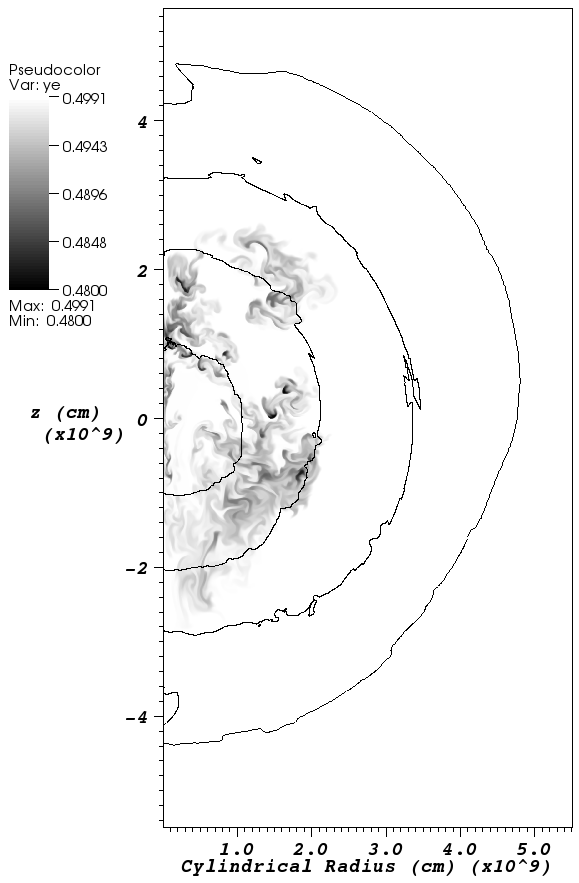
|
Cococubed.com
|
|
Metallicity Effects on White Dwarf Supernovae |
Home
Astronomy research
Software Infrastructure:
MESA
FLASH-X
STARLIB
MESA-Web
starkiller-astro
My instruments
Neutrino Emission:
Neutrinos from de-excitation
Neutrino emission from stars
Identifying the Pre-SN
Neutrino HR diagram
Pre-SN Beta Processes
Pre-SN neutrinos
White dwarf pulsations:
12C(α,γ) & overshooting
Probe of 12C(α,γ)16O
Impact of 22Ne
Impact of ν cooling
Variable white dwarfs
MC reaction rates
Micronovae
Novae
White dwarf supernova:
Stable nickel production
Remnant metallicities
Colliding white dwarfs
Merging white dwarfs
Ignition conditions
Metallicity effects
Central density effects
Detonation density
Tracer particle burning
Subsonic burning fronts
Supersonic fronts
W7 profiles
Massive stars:
Pop III with HST/JWST
Rotating progenitors
3D evolution to collapse
MC reaction rates
Pre-SN variations
Massive star supernova:
Yields of radionuclides
26Al & 60Fe
44Ti, 60Co & 56Ni
SN 1987A light curve
Constraints on Ni/Fe
An r-process
Effects of 12C +12C
Neutron Stars and Black Holes:
Black Hole spectrum
Mass Gap with LVK
Compact object IMF
He burn neutron stars
Stars:
Hypatia catalog
SAGB stars
Nugrid Yields I
He shell convection
BBFH at 40 years
γ-rays within 100 Mpc
Iron Pseudocarbynes
Pre-Solar Grains:
C-rich presolar grains
SiC Type U/C grains
Grains from massive stars
Placing the Sun
SiC Presolar grains
Chemical Evolution:
Radionuclides in 2020s
Zone models H to Zn
Mixing ejecta
Thermodynamics, Opacities & Networks
Radiative Opacity
Skye EOS
Helm EOS
Five EOSs
Equations of State
12C(α,γ)16O Rate
Proton-rich NSE
Reaction networks
Bayesian reaction rates
Verification Problems:
Validating an astro code
Su-Olson
Cog8
Mader
RMTV
Sedov
Noh
Software Instruments
2026 AAS Journals
AAS YouTube
Listing of 500+ Author Videos
AAS Peer Review Workshops
Outreach Material
Education Material
Other Stuff:
Bicycle Adventures
Illustrations
Presentations
Contact: F.X.Timmes
my one page vitae,
full vitae,
research statement, and
teaching statement.
On Measuring The Metallicity Of A Type Ia Supernova's Progenitor (2016)
In Type Ia Supernovae (Sne Ia), the relative abundances of chemical elements are affected by the neutron excess in the composition of the progenitor white dwarf. Since these products leave signatures in the spectra near maximum light, spectral features may be used to constrain the composition of the progenitor.
In this article we calculate the nucleosynthetic yields for three SNe Ia simulations, assuming single degenerate, Chandrasekhar mass progenitors, for a wide range of progenitor metallicities, and calculate synthetic light curves and spectra to explore correlations between progenitor metallicity and the strength of spectral features. We use two 2D simulations of the deflagration-detonation-transition scenario with different $^{56}$Ni yields and the W7 simulation to control for differences between explosion models and total yields.
While the overall yields of intermediate mass elements (16 $<$ A $\le$ 40) differ between the three cases, trends in the yields are similar. With increasing metallicity, $^{28}$Si yields remain nearly constant, $^{40}$Ca yields decline, and Ti and $^{54}$Fe yields increase. In the synthetic spectra, we identify two features at 30 days post explosion that appear to deepen with progenitor metallicity: a Ti feature around 4200 Å and a Fe feature around 5200 Å. In all three simulations, their pseudo equivalent widths show a systematic trend with progenitor metallicity. This suggests that these two features may allow differentiation among progenitor metallicities of observed SNe Ia and potentially help reduce the intrinsic Hubble scatter.

|

|

|
|

|
|

|
|

|
|

|
|
On Silicon Group Elements Ejected by Supernovae Type Ia (2014)
There is evidence that the peak brightness of a Type Ia supernova is affected by the electron fraction Y$_{\rm e}$ at the time of the explosion. The electron fraction is set by the aboriginal composition of the white dwarf and the reactions that occur during the pre-explosive convective burning. To date, determining the makeup of the white dwarf progenitor has relied on indirect proxies, such as the average metallicity of the host stellar population. In this article, we present analytical calculations supporting the idea that the electron fraction of the progenitor systematically influences the nucleosynthesis of silicon group ejecta in Type Ia supernovae.
In particular, we suggest the abundances generated in quasi-nuclear statistical equilibrium are preserved during the subsequent freeze-out. This allows potential recovery of Y e at explosion from the abundances recovered from an observed spectra. We show that measurement of $^{28}$Si, $^{32}$S, $^{40}$Ca, and $^{54}$Fe abundances can be used to construct Y$_{\rm e}$ in the silicon-rich regions of the supernovae.
If these four abundances are determined exactly, they are sufficient to recover Y$_{\rm e}$ to 6%. This is because these isotopes dominate the composition of silicon-rich material and iron-rich material in quasi-nuclear statistical equilibrium. Analytical analysis shows the $^{28}$Si abundance is insensitive to Y$_{\rm e}$, the $^{32}$S abundance has a nearly linear trend with Y$_{\rm e}$, and the $^{40}$Ca abundance has a nearly quadratic trend with Y$_{\rm e}$. We verify these trends with post-processing of one-dimensional models and show that these trends are reflected in the model's synthetic spectra.

|

|

|

|

|
|
Evaluating Systematic Dependencies Of Type Ia Supernovae: The Influence Of Progenitor $^{22}$Ne Content On Dynamics (2009)
In this article we present a theoretical framework for formal study of systematic effects in supernovae Type Ia (SNe Ia) that utilizes two-dimensional simulations to implement a form of the deflagration-detonation transition (DDT) explosion scenario.
The framework is developed from a randomized initial condition that leads to a sample of simulated SNe Ia whose $^{56}$Ni masses have a similar average and range to those observed, and have many other modestly realistic features such as the velocity extent of intermediate-mass elements. The intended purpose is to enable statistically well defined studies of both physical and theoretical parameters of the SNe Ia explosion simulation.
We present here a thorough description of the outcome of the SNe Ia explosions produced by our current simulations. A first application of this framework is utilized to study the dependence of the SNe Ia on the $^{22}$Ne content, which is known to be directly influenced by the progenitor stellar population's metallicity. Our study is very specifically tailored to measure how the $^{22}$Ne content influences the competition between the rise of plumes of burned material and the expansion of the star before these plumes reach DDT conditions. This influence arises from the dependence of the energy release, progenitor structure, and laminar flame speed on $^{22}$Ne content.
For this study, we explore these three effects for a fixed carbon content and DDT density. By setting the density at which nucleosynthesis takes place during the detonation phase of the explosion, the competition between plume rise and stellar expansion controls the amount of material in nuclear statistical equilibrium (NSE) and therefore $^{56}$Ni produced. Of particular interest is how this influence of $^{22}$Ne content compares to the direct modification of the $^{56}$Ni mass via the inherent neutron excess as discussed by Timmes et al. Although the outcome following from any particular ignition condition can change dramatically with $^{22}$Ne content, with a sample of 20 ignition conditions we find that the systematic change in the expansion of the star prior to detonation is not large enough to compete with the dependence discussed by Timmes et al. In fact, our results show no statistically significant dependence of the predetonation expansion on $^{22}$Ne content, pointing to the morphology of the ignition condition as being the dominant dynamical driver of the $^{56}$Ni yield of the explosion. However, variations in the DDT density, which were specifically excluded here, are also expected to be important and to depend systematically on $^{22}$Ne content.

|
|

|

|
The Reduction of the Electron Abundance during the Pre-explosion Simmering in White Dwarf Supernovae (2008)
Prior to the explosion of a carbon-oxygen white dwarf in a Type Ia supernova there is a long "simmering," during which the $^{12}$C + $^{12}$C reaction gradually heats the white dwarf on a long ($\simeq$ 10$^3$ yr) timescale. Piro & Bildsten showed that weak reactions during this simmering set a maximum electron abundance Y$_{\rm e}$ at the time of the explosion. In this article investigate the nuclear reactions during this simmering with a series of self-heating, at constant pressure, reaction network calculations. Unlike in AGB stars, proton captures onto $^{22}$Ne and heavier trace nuclei do not play a significant role. The $^{12}$C abundance is sufficiently high that the neutrons preferentially capture onto $^{12}$C, rather than iron group nuclei.
As an aid to hydrodynamical simulations of the simmering phase, we present fits to the rates of heating, electron capture, change in mean atomic mass, and consumption of $^{12}$C in terms of the screened thermally averaged cross section for $^{12}$C + $^{12}$C. Our evaluation of the net heating rate includes contributions from electron captures into the 3.68 MeV excited state of $^{13}$C . This results in a slightly larger energy release, per $^{12}$C consumed, than that found by Piro & Bildsten, but less than that released for a burn to only $^{20}$Ne and $^{23}$Na . We compare our one-zone results to more accurate integrations over the white dwarf structure to estimate the amount of $^{12}$C that must be consumed to raise the white dwarf temperature, and hence to determine the net reduction of Y$_{\rm e}$ during simmering.

|
|

|

|
On Variations in the Peak Luminosity of Type Ia Supernovae (2003)
Why is there a variation in the peak luminosity of white dwarf supernovae? In this letter we explore the idea that the observed variations in the peak luminosities of Type Ia supernovae (SNe Ia) originate in part from a scatter in metallicity of the main-sequence stars that become white dwarfs.
Previous numerical studies have not self-consistently explored metallicities greater than solar. One-dimensional Chandrasekhar mass models of SNe Ia produce most of their $^{56}$Ni in a burn to nuclear statistical equilibrium between the mass shells 0.2 and 0.8 M$_{\odot}$, for which the electron-to-nucleon ratio Y$_{\rm e}$ is constant during the burn. We show analytically that under these conditions, charge and mass conservation constrain the mass of $^{56}$Ni produced to depend linearly on the original metallicity of the white dwarf progenitor.
Detailed postprocessing of W7-like models confirms this linear dependence. The effect that we have identified is most evident at metallicities larger than solar and is in agreement with previous self-consistent calculations over the metallicity range common to both calculations. The observed scatter in the metallicity (1/3 - 3 Z$_{\odot}$) of the solar neighborhood is enough to induce a 25% variation in the mass of $^{56}$Ni ejected by SNe Ia. This is sufficient to vary the peak V-band brightness by $|\Delta M_V| \simeq$ 0.2. This scatter in metallicity is present out to the limiting redshifts of current observations (z $\lesssim$ 1). Sedimentation of $^{22}$Ne can possibly amplify the variation in $^{56}$Ni mass to $\lesssim$ 50%. Further numerical studies can determine if other metallicity-induced effects, such as a change in the mass of the $^{56}$Ni-producing region, offset or enhance the variation that we identify.

|
|

|

|